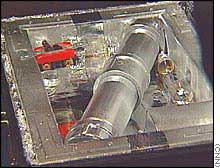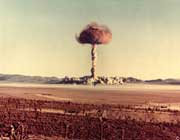|
The following is posted on the National
Terror Alert Resource Center website:
Suitcase Nuclear Device
 A
"suitcase" bomb is a very compact and portable
nuclear weapon and could have the dimensions of 60 x 40
x 20 centimeters or 24 x 16 x 8 inches. The smallest possible
bomb-like object would be a single critical mass of plutonium
(or U-233) at maximum density under normal conditions.
The Pu-239 weighs 10.5 kg and is 10.1 cm across. It doesn't
take much more than a single critical mass to cause significant
explosions ranging from 10-20 tons. These types of weapons
can also be as big as two footlockers. The warhead consists
of a tube with two pieces of uranium, which, when rammed
together, would cause a blast. Some sort of firing unit
and a device that would need to be decoded to cause detonation
may be included in the "suitcase." A
"suitcase" bomb is a very compact and portable
nuclear weapon and could have the dimensions of 60 x 40
x 20 centimeters or 24 x 16 x 8 inches. The smallest possible
bomb-like object would be a single critical mass of plutonium
(or U-233) at maximum density under normal conditions.
The Pu-239 weighs 10.5 kg and is 10.1 cm across. It doesn't
take much more than a single critical mass to cause significant
explosions ranging from 10-20 tons. These types of weapons
can also be as big as two footlockers. The warhead consists
of a tube with two pieces of uranium, which, when rammed
together, would cause a blast. Some sort of firing unit
and a device that would need to be decoded to cause detonation
may be included in the "suitcase."
 Another
portable weapon is a "backpack" bomb. The Soviet
nuclear backpack system was made in the 1960s for use
against NATO targets in time of war and consists of three
"coffee can-sized" aluminum canisters in a bag.
All three must be connected to make a single unit in order
to explode. The detonator is about 6 inches long. It has
a 3-to-5 kiloton yield, depending on the efficiency of
the explosion. It's kept powered during storage by a battery
line connected to the canisters. Another
portable weapon is a "backpack" bomb. The Soviet
nuclear backpack system was made in the 1960s for use
against NATO targets in time of war and consists of three
"coffee can-sized" aluminum canisters in a bag.
All three must be connected to make a single unit in order
to explode. The detonator is about 6 inches long. It has
a 3-to-5 kiloton yield, depending on the efficiency of
the explosion. It's kept powered during storage by a battery
line connected to the canisters.
Effects
External radiation — occurs when
either part of or all of the body is exposed from an external
source, such as when a person is standing near the site
of where a radiological device is set off and he or she
is exposed to radiation, which can be absorbed by the
body or can pass completely through it.
Contamination — occurs when radioactive
materials in the form of solids, liquids or gases are
released into the air and contaminate people externally,
internally or both. This happens when body parts such
as the skin become contaminated and/or if the harmful
material gets inside the body via the lungs, gut or wounds.
Incorporation of radioactive material
— occurs when body cells, tissues and organs such
as bone, liver, thyroid or kidney, are contaminated.
 Gamma
radiation can travel many meters in the air and many centimeters
once in human tissue; therefore they represent a major
external threat. Dense material is needed as a shield.
Beta radiation can travel meters in air and can moderately
penetrate human skin, but clothing and some protection
can help. Alpha radiation travels a very short distance
through the air and can't penetrate the skin, but can
be harmful if inhaled, swallowed or absorbed through open
wounds. Gamma
radiation can travel many meters in the air and many centimeters
once in human tissue; therefore they represent a major
external threat. Dense material is needed as a shield.
Beta radiation can travel meters in air and can moderately
penetrate human skin, but clothing and some protection
can help. Alpha radiation travels a very short distance
through the air and can't penetrate the skin, but can
be harmful if inhaled, swallowed or absorbed through open
wounds.
Radiation in the first hour after an explosion
is about 90 percent, with it going down to about 1 percent
of the original level after two days. Radiation only drops
to trace levels after 300 hours.
Symptoms
People in the immediate vicinity would
likely die from the force of the conventional explosion
itself. Some survivors of the blast might die of radiation
poisoning in the weeks afterward. Those farther away from
the explosion might suffer radiation sickness in the days
and weeks afterward, but recover. Over time, risks of
cancer in the affected area would rise, but perhaps only
slightly.
A mix of physical symptoms must be used
to judge the seriousness of exposure. Impact of radiation
poisoning also changes if the body has experienced burns
or physical trauma. In the case of treatable victims,
extensive medical treatment may be needed for more than
two months after exposure.
Some symptoms may include vomiting, headache,
fatigue, weakness, diarrhea, thermal burn-like skin effects,
secondary infections, reoccurring bleeding and hair loss.
Treatment
If detection and decontamination occurs
soon after exposure, about 95 percent of external radioactive
material can be removed by taking off the victim's clothing
and shoes and washing with water. Further decontamination
may require the use of bleaches or other mild abrasives.
Treatment of a victim within the first
six weeks to two months after exposure is vital and is
determined by what types of radioactive isotopes to which
the victim was exposed.
Medical personnel will treat victims for
hemorrhage and shock. Open wounds are usually irrigated
to cleanse them of any radioactive traces. Amputation
of limbs may occur if a wound is highly contaminated and
functional recovery isn't likely.
If radioactive material is ingested, treatment
is given to reduce absorption and enhance excretion and
elimination. It includes stomach pumping or giving the
victim laxatives or aluminum antacids, among other things.
If radioactive material has gotten into
a victim's internal organs and tissues, treatment includes
giving the patient various blocking and diluting agents,
such as potassium iodide, to decrease absorption. Mobilizing
agents such as ammonium chloride, diuretics, expectorants
and inhalants are given to a patient to force the tissues
to release the harmful isotopes. Other treatments involve
chelating agents. When ingested, these agents bind with
some metals more strongly than others to form a stable
complex that, when soluble, are more easily excreted through
the kidneys.
|